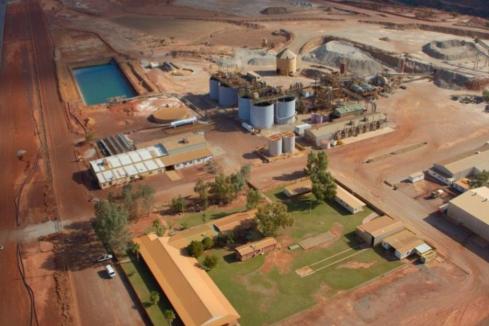In this edition of Bulls N’ Bears Big Hits, we examine some notable drill intercepts revealed on the ASX, including from Ora Gold’s Crown Prince which hit 20m at 277.36g/t gold, including 4m at 1368g/t gold. We also take a close look at other interesting drill hits from last week as reported by Axel Rare Earths’ hit from Brazil and Piche Resources big uranium hit in WA’s Ashburton region.


In this edition of Bulls N’ Bears Big Hits, we examine some notable drill intercepts revealed on the ASX, including at Ora Gold’s Crown Prince which hit 20m at 277.36g/t gold, including 4m at 1368g/t gold.
We also take a close look at other interesting drill hits from last week as reported by Axel Rare Earths’ hit from Brazil and Piche Resources’ big uranium hit in WA’s Ashburton region.
So, let’s dive in.
Ora Gold
Crown Prince Prospect – Garden Gully gold project – Meekatharra, WA
Gold
One of Ora Gold’s reverse-circulation (RC) drillholes punched out an attention-grabbing primary intercept of 20m at 277.36g/t gold from 40m, including a 4m composite grading a staggering 1368g/t gold - almost 1.4 kilograms of gold per tonne - from 52m depth.
The hole ended at 60m depth with the final 4m sample interval – part of the Big Hit intercept – assaying an average of 13.57g/t from initial and repeat assays over the last 4m, meaning the mineralisation remains open beyond its current depth.
Tantalisingly, while the first 0-44m of the hole seems to have been sampled at 1m intervals, analyses for the bottom 16m of the run were undertaken on 4m composite samples between 44m and end-of-hole (EOH) at 60m.
So somewhere in that 16m run of 4m composites – which includes the 1368.11g/t gold headline grade averaged from two analyses - there must be some really interesting 1m interval gold grades.
Additionally, the same hole came up with a more modest but still significant near-surface run of 3m at 2.23 g/t gold, averaged from an initial and a follow-up assay, from just 25m depth.
Other solid hits are seen from other recent results, too. The next best three intercepts were 15m at 14.7g/t gold from 152m; 9m at 21.44g/t gold from 28m, including 2m at 77.8g/t gold from 31m; and 7m at 11.74g/t gold from 132m.
Recent work at the site has included completion of infill-drilling ahead of finalising and releasing a new resource estimate. Most drilling has focussed on mineralisation in the company’s notional Crown Prince pit design which encloses inferred mineral resources, with the expectation of confirming and improving gold grades in a few key areas.
Other bonuses from the infill drilling include identification of new near-surface high grade zones and parallel lodes in new positions in the footwall and hanging wall of the SEZ. Those zones also fall within an initial conceptual open pit for the deposit and are expected to augment the mineral resource and future mining inventory.
Importantly, grades returned in the latest infill drilling support the current model and confirm previously reported grades.
The Crown Prince prospect is a high-grade gold deposit in the company’s 677 sq km Garden Gully project tenement package, 22km north-west of Meekatharra in Western Australia.
The deposit was mined between 1908 and 1915, along two gold-rich quartz veins via four underground levels, to a vertical depth of 90m.
Historic production was 29,400 tonnes for 20,178 ounces at a recovered grade of 21.7g/t gold, using gravity and cyanidation processing, but the prospect has seen no further mining since.
The belt-scale suite of the Garden Gully tenements enclose a big chunk of the Archaean-age Abbotts Greenstone Belt (AGB) which contains multiple gold prospects, of which Crown Prince is the most advanced.
The dominant structural feature of the AGB is the Abernethy shear zone, which runs along the southeastern margin of the belt and has multiple north-trending splays which contain widespread gold anomalism penetrating various rock-types in the belt.
Crown Prince is situated on one of the splays towards the northern end of the Abernethy shear, with gold mineralisation being discovered from surface in late 2022 in a previously unmined area.
On 15th December 2022, the company highlighted a SEZ drill intercept of 7m at 15.75g/t gold from 30m, including 6m going 38.06g/t gold from 41m.
Follow-up exploration in 2023 soon defined the never-mined SEZ which encloses the main mineralised area at Crown Prince.
Further work has delivered exceptional high-grade gold drilling results from shallow depths which, along with other parallel lodes identified in multiple phases of drilling over the last two years, have been woven into the company’s latest resource estimation database.
Crown Prince is a structurally-controlled, orogenic type of mineralisation hosted within west/north-west – east/south-east striking quartz-rich lodes which dip steeply southwards. The lodes are offset by north-south to north/north-east trending shears, which appear to have a near-vertical or steep westward dip.
Both south-eastern and a north-western extensions from the main ore zone have been identified in drillholes designed to cover those directions.
Supergene gold mineralisation also occurs in the near-surface indurated and saprolitic layers in the lateritic profile.
The first modest mineral resource estimate for Crown Prince in mid-October 2019 comprised 479,000 tonnes at 3.6g/t gold for 56,000 ounces of gold.
Ora has since advanced the project to the point where a February 2024 update increased the resource to 1.84 million tonnes at a grade of 4.1g/t gold for a total of 240,000 ounces of gold.
Indicated category resource material contributes 59 per cent of the total resource tonnage and 68 per cent of the gold. A major proportion of this is underpinned by Ora’s maiden estimate for the SEZ which contributes a majority 164,000 ounces at a grade of 5.2g/t gold.
The bulk of the resource is shallow and represents strong potential for exploitation by open-pit mining.
Recent drilling has brought the drill spacing at the SEZ down to about 15m-by-15m which Ora considers adequate to define a mostly-indicated category in its latest resource estimation modelling for an update which is expected in November-December.

Caption - Axel Rare Earths Caladão Project is a 400km² tenement in the region of Minas Gerais in Brazil, known as ‘Lithium Valley’. It includes 25 sq km of mineralised rare earths strike with follow-up drilling planned to target a maiden mineral resource estimate. Credit: File
Axel Rare Earths (AXL)
Caladão Project – Minas Gerais – Brazil
Rare earths.
Axel Rare Earths’ first diamond drill-hole put into its flagship Caladão rare earths project in Minas Gerais, Brazil, has bored its way through a thick, clay-hosted, near-surface zone of rare earths mineralisation, pulling up an exceptional high-grade intercept of 12.4m at 5478ppm total rare earths oxides (TREO) from 14m and includes 2m at a scorching 12,454ppm TREO from 18m.
The hole also intercepted a shallower zone of 4m at a grade of 1473ppm TREO from 7m and ended in mineralisation at 26.4m - still in mineralisation and with the final 3.4m averaging 4381ppm TREO.
Individual 1m rare earths grades in the hole for the more highly-valued “magnet duos of neodymium- praseodymium (NdPr) and dysprosium-terbium (DyTb) attained a maximum of 2712ppm for the former and 124ppm for the latter.
Assays from a number of auger holes also intercepted wide zones of mineralisation with continuous zones of high TREO grades, pointing to a potentially massive mineralised footprint within the project area.
Nearby auger drill holes also jagged broad, high-grade zones of rare earths mineralisation, with the best hole intercepting hole 12m at 1932ppm TREO from surface, ending with 1m assaying 4033ppm TREO from 11m.
A second auger hole nailed 10m at 1566ppm TREO from 3m and ended with 2m at 2757ppm TREO from 11m.
The key intercepts demonstrate significant TREO concentrations and confirm the potential for strong concentrations of the sought-after,high-value “magnet” rare earth neodymium and praseodymium (NdPr) within the targeted zones.
Caladão is one of four prospective rare earths and niobium projects held by the company whose total coverage spans more than 1100 sq km in three Brazilian states.
The current 2600m Caladão drilling program is Axel’s second exploration program which it is running concurrently with a drilling program at its Caldas prospect to test the possibility that high-grade rare earths could occur along the contact zone of the alkaline complex – a premise which seems to be borne out by early results.
The Phase-1 Caladão program is currently planned to be part of a 20,000m program to be conducted over the next two years.
The proposed aggressive diamond drilling program aims primarily to extend rare earths mineralisation believed to remain open at two prospects - Area A and Area B – which previous work revealed over a mineralised strike of about 25km which also features a large circular structure at Area B carrying a radiometric signature.
The program is also designed to test the depth of the clay profile with diamond drilling where previous auger drilling to an average depth of 15m indicated that rare earths mineralisation is open at depth.
This first program will include 52 holes and is anticipated to total about 2,600m of diamond drilling.
The Caladão project lies within the Lithium Valley in the north-east of the Brazilian State of Minas Gerais. The region spans about 150,000 sq km and is known for major pegmatite-hosted lithium discoveries including Sigma Lithium Corporation’s Grota do Cirilo lithium mine and Latin Resources’ Colina deposit.
Initial assays from the program highlight the project’s significant rare earths mineralisation potential, with extensive lateral continuity of thick, high-grade intersections logged in the diamond core hole underscoring the potential for the Caladão project to develop into a major clay-hosted rare earths discovery in Brazil.
Rare earths mineralisation at the project is associated with thick and laterally persistent clay-rich saprolite layers developed by intense weathering of the Caladão Granite and the Padre Paraíso Charnockite.
Piche Resources (PR2)
Ashburton project – Western Australia
Uranium
When Piche Resources drilled one of its recent diamond drill holes into the company’s “Angelo B” prospect in its Ashburton uranium project, it cored through 39.28m of the spectacular Mid-Proterozoic Bresnahan Formation to pull up a uranium oxide equivalent grade of 553ppm uranium oxide equivalent (as eU3O8) from 124.12m.
The vertical intercept includes 1.28m at a grade of 1460ppm eU3O8 from 125.46m; and 1.02m at 954ppm eU3O8 from 128.8m; and 0.84m at 1184ppm eU3O8 from 151.54m and 2.42m at 2681ppm eU3O8 from 155.10m.
The latter includes 1.22m at 3985ppm eU3O8 from 156.3m which includes 0.94m at 4963m eU3O8 from 156.5m; and 1.90m at 2215ppm eU3O8 from 161.40m; and 0.72m at 3787ppm eU3O8 from 161.46m.
Piche Resources’ latest drilling results were part of the company’s reverse-circulation (RC) and diamond drilling involving a further eight holes at its Ashburton uranium project, 140km west/south-west of Newman in WA’s Pilbara region.
The 39.28m diamond core-hole delivered the longest intersection recorded to date by the company, immediately above the Proterozoic unconformity.
Analyses of the drill core containing the headline 39.28m intercept has proven a north-west structural control on mineralisation, the presence of uranium mineralisation along the unconformity and also within the overlying sandstone and the basement.
Taken together, the results generally confirm the potential for both high grades and broad zones of mostly flat-lying uranium mineralisation both above the Proterozoic unconformity (at Angelo B) and also below it (at Angelo A). It has also confirmed historical drill results from over 40 years ago.
The diamond hole has also highlighted the potential to expand the area of mineralisation at both the “Angelo A” and “Angelo B” prospects, and along strike to the north-west and south-east.
The interpreted long-section “C” at the “Angelo A” prospect shows multiple intercepts in 10 RC holes in various mineralised lenses, with all but one lying entirely below the Proterozoic unconformity, with only one drill intercept appearing to transect the horizon with 0.5m at a grade of 489ppm uranium.
The average depth of uranium of the multiple intercepts is about 40m below the unconformity – or 100m below surface - with uranium grades ranging between about 500ppm and 5129ppm uranium, as eU3O8.
The biggest lens interpreted in long-section measures about 170m long and a maximum of about 15m thick.
The interpreted cross-section “A” at the “Angelo B” target depicts a lens of uranium mineralisation about 39m thick and about 195m long on section with a 25o dip to the east centred at about 120m below surface, with the bottom of the lens in near the base of the Bresnahan Formation, about 15m above the unconformity.
Other nearby assays in the same stratigraphic position on the section run between 520 and 2700ppm uranium eU3O8.
Additionally, historical drilling has returned significant results along strike -but off section “A” – which include one hole returning 1.5m at 1043ppm uranium oxide (as U3O8) and 2.0m at 2965ppm uranium oxide with a peak value of 0.5m assaying 5800ppm uranium oxide.
The drilling campaign involved 1776m of RC drilling and 1147m of diamond drilling for a total of 18 holes.
Piche says it will conclude the program with an additional diamond hole to assist with accurate compilation of the geology to refine the geological model. This will inform future exploration planning at the Angelo A and B prospects and other project areas south of the Angelo area, which includes 50km of strike with multiple high-priority mineral occurrences.
Almost all of the mineralisation lies at or near the unconformity as expected, but with it being identified in both the upper Bresnahan Formation and the lower Wyloo suite of rocks - above and below the unconformity, respectively - a number of possibilities exist which could greatly increase the mineralisation potential.
This is particularly in view of high grade uranium oxide intercepts between 2000 and 5000ppm being commonplace – and even accompanied by a single 0.34m interval of 16,050ppm uranium oxide (as eU3O8) in one RC hole.
Is your ASX-listed company doing something interesting? Contact: matt.birney@wanews.com.au











